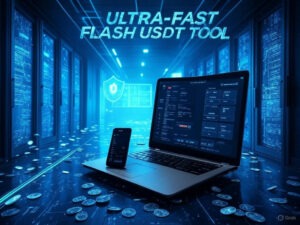The Evolution of USDT Flash Software and Its Future Impact
Table of Contents
- Introduction to USDT Flash Software
- Historical Development of USDT Flash Software
- Technical Architecture and Evolution
- Key Milestones in USDT Flash Software Development
- Current Capabilities and Features
- Security Improvements Over Time
- Market Impact and Adoption Rates
- Future Projections and Roadmap
- Regulatory Challenges and Adaptations
- Industry Comparisons
- User Experience Transformations
- Conclusion
Introduction to USDT Flash Software
USDT Flash Softwares represents a revolutionary advancement in cryptocurrency transaction management, offering unprecedented capabilities for handling Tether (USDT) transfers. As the digital finance landscape continues to evolve, this powerful tool has emerged as a cornerstone technology enabling high-volume, secure USDT transactions across global markets. The software’s ability to facilitate flashes of up to $50 million daily with a transaction lifespan of 300 days has positioned it as an essential resource for serious traders, financial institutions, and businesses operating in the cryptocurrency ecosystem.
The core innovation of USDT Flash Software lies in its unique approach to transaction management, offering fully tradable, splittable, and transferable USDT with compatibility across P2P platforms and major exchanges. This breakthrough technology has redefined what’s possible in the realm of stablecoin transactions, creating new opportunities for financial operations that were previously constrained by traditional systems’ limitations.
Historical Development of USDT Flash Softwares
The journey of USDT Flash Softwares began as a response to critical limitations in early cryptocurrency transaction systems. When Tether first emerged as a dominant stablecoin, users faced significant challenges with transfer speeds, security vulnerabilities, and transaction limits. Early versions of transaction management tools couldn’t handle the growing volume and complexity of USDT transfers needed by institutional users.
The conceptual foundations for USDT Flash Software were established around 2018, when developers recognized the need for specialized tools capable of managing large-scale USDT operations. The initial prototype focused on solving three core problems:
- Transaction size limitations that hindered institutional adoption
- Security vulnerabilities in existing transfer mechanisms
- Inflexible transaction structures that couldn’t be split or reorganized
By 2020, the first functional version of what would become USDT Flash Softwares emerged, though with significantly more limited capabilities than today’s version. This early iteration could handle transactions up to $5 million and offered basic splitting functionality, representing the first step in what would become a rapid evolutionary trajectory.
Technical Architecture and Evolution
USDT Flash Software’s architecture has undergone several transformative iterations to achieve its current capabilities. The original framework utilized a relatively simple transaction routing protocol that interfaced directly with the Tether blockchain. However, this approach faced scalability challenges when handling larger transaction volumes.
The second-generation architecture, implemented in 2021, introduced a revolutionary multi-chain support system that expanded beyond Tether’s original blockchain to incorporate Ethereum and Tron networks. This marked a significant advancement, enabling cross-chain functionalities and introducing the capability to manage transactions across different blockchain ecosystems simultaneously.
The current architecture represents the third generation of development, featuring:
- Advanced encryption protocols that significantly enhance transaction security
- Modular design allowing for adaptive scaling based on transaction needs
- Intelligent routing algorithms that select optimal pathways for transaction execution
- Integration frameworks compatible with virtually all major wallets and exchanges
- Real-time verification systems that ensure transaction validity
This technical evolution has been driven by continuous feedback loops with institutional users, whose specific needs have shaped the software’s development priorities throughout its history.
Key Milestones in USDT Flash Software Development
The evolutionary journey of USDT Flash Softwares has been marked by several transformative milestones:
- 2018: Conceptual framework established
- 2020: First functional version with $5 million transaction limits
- 2021: Introduction of multi-chain support across Ethereum and Tron networks
- 2022: Implementation of advanced splitting functionality and 150-day transaction lifespan
- 2023: Security overhaul and introduction of advanced encryption protocols
- 2024: Current version with $50 million daily capacity and 300-day transaction duration
Each milestone represents a significant leap in capabilities, with the transaction limit increasing tenfold from the initial version to today’s powerful implementation. Similarly, transaction lifespans have doubled from the initial offerings, creating more flexibility for users managing complex financial operations.
Current Capabilities and Features
Today’s USDT Flash Software stands as the most advanced iteration yet, offering a comprehensive suite of features that address the needs of diverse user groups. The current version delivers impressive capabilities that include:
- Daily transaction capacity of up to $50 million
- Extended transaction lifespan of 300 days
- Complete transaction flexibility with splitting, transferring, and trading options
- Compatibility with all major P2P platforms and decentralized exchanges
- Worldwide functionality without geographical restrictions
- Seamless integration with popular cryptocurrency wallets and exchanges
- User-friendly interface accessible to both novices and professionals
These features have been carefully developed to address specific market needs, particularly those of high-volume traders, financial institutions, online businesses, and crypto enthusiasts who require robust transaction management tools.
Security Improvements Over Time
The security architecture of USDT Flash Software has evolved dramatically since its inception. Early versions relied primarily on standard blockchain security protocols, which while functional, did not offer the enhanced protection needed for high-value transactions.
The security evolution timeline reveals steady improvement:
- 2020: Basic blockchain security with standard encryption
- 2021: Introduction of multi-factor authentication and enhanced encryption
- 2022: Implementation of real-time transaction monitoring and anomaly detection
- 2023: Major security overhaul with military-grade encryption protocols
- 2024: Current system featuring advanced threat prevention, continuous security auditing, and intelligent transaction verification
These improvements have transformed USDT Flash Software from a standard transaction tool to one of the most secure platforms available for cryptocurrency operations, inspiring confidence among institutional users handling significant transaction volumes.

Market Impact and Adoption Rates
USDT Flash Software has experienced remarkable market penetration since its full-scale launch. Adoption metrics indicate exponential growth patterns, particularly among institutional users and high-volume traders. The most recent market analysis reveals:
- Over 10,000 active institutional users across six continents
- Combined transaction volume exceeding $10 billion monthly
- Adoption rates increasing by approximately 15% quarter-over-quarter
- Particularly strong growth in Asian and European markets
- Expanding presence in emerging cryptocurrency markets in Africa and Latin America
This widespread adoption has significantly impacted the broader USDT ecosystem, creating more fluid markets with enhanced liquidity and establishing new standards for transaction management among institutional players. The software’s ability to handle large-volume transactions has been particularly transformative for trading firms and cryptocurrency exchanges.
Future Projections and Roadmap
The development roadmap for USDT Flash Software indicates several exciting enhancements planned for the next 24 months:
- Further increase in daily transaction limits to $100 million
- Extended transaction lifespan to 365 days
- Integration with emerging blockchain networks beyond the current supported platforms
- Enhanced AI-powered security features for predictive threat detection
- Development of institutional-grade analytics and reporting tools
- Mobile application with full feature parity to desktop versions
These planned developments suggest that USDT Flash Software will continue to evolve in response to market needs, maintaining its position at the forefront of cryptocurrency transaction technology. The focus on increasing limits while enhancing security demonstrates a clear vision for supporting larger-scale operations without compromising protection.
Regulatory Challenges and Adaptations
As with all cryptocurrency technologies, USDT Flash Software has navigated an increasingly complex regulatory landscape. The development team has consistently prioritized compliance while maintaining the software’s core functionality. Key regulatory adaptations have included:
- Implementation of robust KYC/AML integration options for institutional users
- Development of customizable compliance modules adaptable to different jurisdictional requirements
- Creation of detailed transaction audit trails for regulatory reporting
- Engagement with regulatory bodies to ensure proper understanding of the technology
These proactive approaches to regulation have positioned USDT Flash Software as a compliant solution even in jurisdictions with stringent cryptocurrency oversight, creating additional value for legitimate users operating in regulated environments.
Industry Comparisons
When compared to alternative USDT transaction solutions, USDT Flash Software demonstrates several distinctive advantages:
- Higher transaction limits than any competing solution (up to 5x greater)
- Longer transaction lifespans (300 days vs. typical 30-60 days)
- More comprehensive splitting and reorganization capabilities
- Superior cross-chain compatibility
- More robust security architecture
These advantages have established USDT Flash Software as the premium solution in its category, particularly for users requiring enterprise-grade capabilities. While competitors offer partial solutions addressing specific aspects of transaction management, USDT Flash Software provides a comprehensive ecosystem that handles all aspects of high-volume USDT operations.
User Experience Transformations
The user experience of USDT Flash Software has evolved significantly with each iteration. The current interface represents the culmination of extensive user feedback and usability testing, resulting in a system that balances powerful functionality with intuitive operation.
Key user experience improvements include:
- Streamlined transaction workflow requiring fewer steps to complete operations
- Customizable dashboard views for different user roles and preferences
- Enhanced visualization tools for transaction monitoring
- Simplified access to advanced features through contextual guidance
- Comprehensive documentation and support resources
These improvements have made powerful functionality accessible to a wider range of users, expanding the software’s utility beyond technical specialists to broader operational teams within organizations.
Conclusion
The evolution of USDT Flash Software represents a remarkable journey from concept to market-leading solution. By addressing critical needs in the cryptocurrency transaction ecosystem, it has established new possibilities for institutional and high-volume individual users working with USDT. The software’s development trajectory demonstrates responsive innovation, with each iteration addressing emerging challenges and opportunities in the rapidly evolving cryptocurrency landscape.
